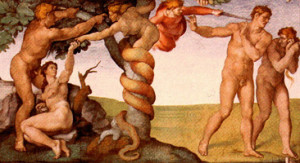By Dorothea Shefer-Vanson


JERUSALEM — Snakes Alive!
The setting was a club for retired people in one of Jerusalem’s more prosperous and prestigious neighbourhoods. Most of its members are ladies of a certain age or more, well-dressed, well-coiffed and well-preserved, with a sprinkling of elderly gents. They spend their spare time engaging in activities which help to cultivate the mind and the body (learning languages, making ceramic vases, painting, exercising), and attend a weekly lecture on a subject of general interest.
This particular weekly lecture (one of a series of four) was on ‘The Origins of Civilisation in the Ancient Near East.’ After devoting some time (illustrated copiously with slides) to the development of prehistoric man, the lecturer began to expound on man’s progression from hunter-gatherer to cultivator of crops and animals.
This brought him to talk about the change this had wrought in the prehistoric way of life and it was at this point that he turned to the audience and asked: “Which was the first animal to be domesticated by man?”
Before anyone could formulate a reply, one dear old biddie shouted out “the snake!”
The lecturer gave a polite shake of his head and turned to the next person who had raised her hand, and eventually someone came up with the correct answer, the dog, man’s best—and first—friend.
I was there because of my connection with the lecturer, though I suppose as far as age (though not my area of residence) is concerned I could be considered eligible to belong. When the lady in the row in the front row shouted out ‘the snake!’ I was at first stunned, then bemused and finally amused. In fact, I had to devote the next half-hour to maintaining my composure and preventing myself from laughing out loud. Heaven forfend that I should offend a single one of those old dears!

Later, I began to wonder why the snake should have been the first creature to spring to anyone’s mind. Of course, it is the first creature mentioned in the Bible, where it is called the serpent, and is even given the gift of speech. I wonder what happened to that attribute of snakes. And then I began to wonder about the other attributes of snakes.
Snakes seem to have had a hypnotic effect on mankind since time immemorial. This is probably connected with our subconscious, as the snake is easily recognizable as a phallic symbol. In fact, Freud pointed this out in his ‘Interpretation of Dreams,’ while Jung regarded dreaming of snakes as representing some kind of inner conflict.
The snake wound round a stick is universally recognized as a symbol of medicine, and may still be seen to this day to denote the location of pharmacies in many countries. This goes back to the ancient Greeks, who regarded snakes as sacred and used them in healing rituals. Snake venom was thought to be remedial, and the fact that snakes shed their skin was seen as a symbol of rebirth and renewal.
A snake wound round a rod was the emblem of Asclepius, the god of medicine and healing in the ancient Greek religion. In fact, the original temples of healing were known as aclepeieion and were to be found on the Island of Kos. Non-venomous snakes were allowed to crawl around freely on the floor in dormitories where the sick and injured slept. Kos was also the home of Hippocrates, the legendary ‘father of medicine’ and originator of the Hippocratic oath that is still in use today in the graduation ceremony of medical students, and the original Hippocratic oath began with the invocation ‘I swear by Apollo the Physician and by Asclepius and by Hygieia and Panacea and by all the gods…’
Today, however, snakes are generally despised and feared. Caravaggio’s painting of Madonna and Child with Saint Anna (the grandmother) shows the (uncircumcised) infant Jesus and his mother treading on—and presumably killing—the snake which in this context represents evil and possibly also original sin (remember the phallic symbol?).
It is a natural human reaction to recoil from something that appears at first sight to be ugly, evil and even disgusting (though many snakes have a beauty of their own), and it seems that this particular picture attributes all those characteristics to the snake. This very human reaction goes back a long way in time, and may even be some atavistic memory that has remained imprinted on the human brain.
So, while the lady in the audience was wrong to think that snakes were ever domesticated, they certainly have been accompanying mankind since time immemorial.
*
Shefer is a freelance writer and translator based in the Jerusalem suburb of Mevasseret Zion. She may be contacted via dorothea.shefer@sdjewishworld.com